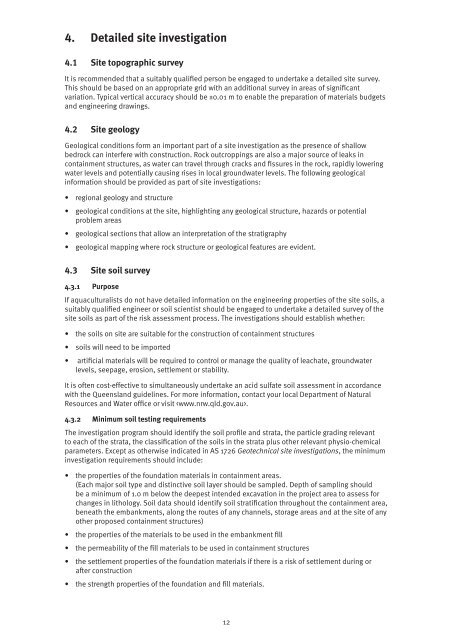Guidelines for constructing and maintaining aquaculture ...
Guidelines for constructing and maintaining aquaculture ...
Guidelines for constructing and maintaining aquaculture ...
Create successful ePaper yourself
Turn your PDF publications into a flip-book with our unique Google optimized e-Paper software.
4. Detailed site investigation<br />
4.1 Site topographic survey<br />
It is recommended that a suitably qualified person be engaged to undertake a detailed site survey.<br />
This should be based on an appropriate grid with an additional survey in areas of significant<br />
variation. Typical vertical accuracy should be ±0.01 m to enable the preparation of materials budgets<br />
<strong>and</strong> engineering drawings.<br />
4.2 Site geology<br />
Geological conditions <strong>for</strong>m an important part of a site investigation as the presence of shallow<br />
bedrock can interfere with construction. Rock outcroppings are also a major source of leaks in<br />
containment structures, as water can travel through cracks <strong>and</strong> fissures in the rock, rapidly lowering<br />
water levels <strong>and</strong> potentially causing rises in local groundwater levels. The following geological<br />
in<strong>for</strong>mation should be provided as part of site investigations:<br />
• regional geology <strong>and</strong> structure<br />
• geological conditions at the site, highlighting any geological structure, hazards or potential<br />
problem areas<br />
• geological sections that allow an interpretation of the stratigraphy<br />
• geological mapping where rock structure or geological features are evident.<br />
4.3 Site soil survey<br />
4.3.1 Purpose<br />
If aquaculturalists do not have detailed in<strong>for</strong>mation on the engineering properties of the site soils, a<br />
suitably qualified engineer or soil scientist should be engaged to undertake a detailed survey of the<br />
site soils as part of the risk assessment process. The investigations should establish whether:<br />
• the soils on site are suitable <strong>for</strong> the construction of containment structures<br />
• soils will need to be imported<br />
• artificial materials will be required to control or manage the quality of leachate, groundwater<br />
levels, seepage, erosion, settlement or stability.<br />
It is often cost-effective to simultaneously undertake an acid sulfate soil assessment in accordance<br />
with the Queensl<strong>and</strong> guidelines. For more in<strong>for</strong>mation, contact your local Department of Natural<br />
Resources <strong>and</strong> Water office or visit .<br />
4.3.2 Minimum soil testing requirements<br />
The investigation program should identify the soil profile <strong>and</strong> strata, the particle grading relevant<br />
to each of the strata, the classification of the soils in the strata plus other relevant physio-chemical<br />
parameters. Except as otherwise indicated in AS 1726 Geotechnical site investigations, the minimum<br />
investigation requirements should include:<br />
• the properties of the foundation materials in containment areas.<br />
(Each major soil type <strong>and</strong> distinctive soil layer should be sampled. Depth of sampling should<br />
be a minimum of 1.0 m below the deepest intended excavation in the project area to assess <strong>for</strong><br />
changes in lithology. Soil data should identify soil stratification throughout the containment area,<br />
beneath the embankments, along the routes of any channels, storage areas <strong>and</strong> at the site of any<br />
other proposed containment structures)<br />
• the properties of the materials to be used in the embankment fill<br />
• the permeability of the fill materials to be used in containment structures<br />
• the settlement properties of the foundation materials if there is a risk of settlement during or<br />
after construction<br />
• the strength properties of the foundation <strong>and</strong> fill materials.<br />
12

















